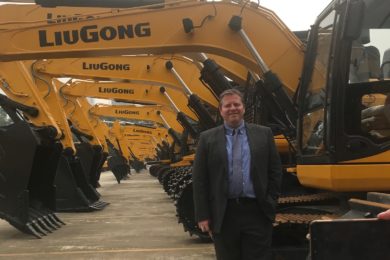I wrote this month’s leader, which will also head up our May 2019 print issue, travelling at speeds of well over 300 km/h on a Chinese high speed train between Luoyang and Changsha. The network of bullet trains that now crisscross the country on their own indicate the strength of Chinese engineering expertise and a determination to further accelerate economic development across the country.
This visit was one I had wanted to do for many years and it remains a first for the mining press. I visited six different major OEM players in the mining equipment sector. First, North Hauler in Baotou, by far the Chinese leader in the supply of mining trucks, up to 300 t plus with electric drive & having just developed a fully autonomous model. Second Taiyuan Heavy in the city of Taiyuan, the leading Chinese rope shovel manufacturer under the TZ brand and including the WK-75 which remains the largest mining shovel ever built until Komatsu delivers its new 4800XPC to Teck Resources in Canada in the coming months. Third, CITIC Heavy in Luoyang, the clear leader in the supply of mining crushers, grinding mills and mine winders in China. I went on to visit XEMC in Xiangtan, another mining truck major, along with Liugong in Liuzhou and SANY in Shenyang, two construction equipment giants but with big plans in mining. I also met with XCMG during the Bauma show in Munich, another construction major but already having had significant export sales of mining units; and have corresponded with JCHX, China’s leading underground mining constructor and contractor, including contract mining and shaft sinking.
So rather than just listing names, what had I learnt so far? I’d certainly learnt more about how these companies tick in a few days of spending time with them than I did in 20 years of writing about them, often relying on snippets from scant English website versions or attempting to reach out by email with mixed success. Of course in the end I have been able to make great contacts with the right people in recent years, and it is through these contacts that the visits have been made possible.
First, these companies have long histories of engineering experience in China and didn’t just pop up from nowhere. Second, having seen their manufacturing facilities with my own eyes, they have the very latest machining, welding and other equipment in place. Third, they are a lot more vertically integrated in their manufacturing than Western companies, many of which now are largely assemblers of components, parts and castings sourced from third parties. Several factories I saw already employ robotic welding and other technology. Fourth, they are investing in the same types of sensors and analytics systems as Western companies to provide mining customers with the same options, from collision avoidance to payload monitoring and autonomy. Fifth, they are using external components of the same quality as those used by Western OEMs, including Cummins or MTU engines, GE or Siemens electric drives, Parker and Bosch hydraulics, Allison tranmissions, SKF bearings, the list goes on. Sixth, they are not as tied to the Chinese state as people think, if anything they receive no special help from the Chinese government at all. A good example is the recent trade war with President Trump’s US administration. China recently responded to US tariffs by imposing tariffs of its own on US imports into China, hugely increasing certain component costs for Chinese OEMs. Chinese regulations relating to emissions and the environment have also been getting much tighter within only a few years – Western OEMs had far more time to adjust to this type of legislation.
In the export market these companies also face significant barriers. Several referred to the “Chinese factor” where they come up across bias against Chinese equipment and services in an already conservative mining industry, due to widely circulating stories of poor quality machines based on old style engineering or simply copies of Western machines. Or a belief that Chinese groups provide zero follow up service and maintenance. The reality is that the majority of the companies I visited have already become certified suppliers with mining majors, including the likes of BHP, Codelco, Rio Tinto, Glencore and Anglo American. This has come about after many, many visits by mining company delegations to their facilities in China to check manufacturing quality and capability. The fact that these certifications have been achieved at all is testament to the quality levels that have been reached. A brief look at Alibaba and other trading websites shows that there remain many lower tier Chinese mining equipment suppliers trying to “make it” but if anything they are copying the premium Chinese players not just the Western imports.
It is true that service is an area that has been lacking to date in some parts of the world. But where these players have made significant sales abroad, they are also catching up in provision of service through new facilities, permanent service engineers in place and parts warehouses in countries like Australia, South Africa and Chile.
With new mines increasingly owned or at least funded by Chinese investment and being built by Chinese EPC contractors, there is no getting away from the fact that the premium Chinese OEMs will grow in stature in the global market in the coming years as the market picks up. And as I have tried to do, isn’t it better to get to know them and develop good relationships sooner rather than later?










